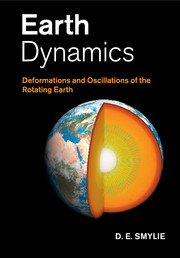Book contents
- Frontmatter
- Contents
- Preface and acknowledgments
- The book website www.cambridge.org/smylie
- 1 Introduction and theoretical background
- 2 Time sequence and spectral analysis
- 3 Earth deformations
- 4 Earth's rotation: observations and theory
- 5 Earth's figure and gravitation
- 6 Rotating fluids and the outer core
- 7 The subseismic equation and boundary conditions
- 8 Variational methods and core modes
- 9 Static deformations and dislocation theory
- Appendix A Elementary results from vector analysis
- Appendix B Properties of Legendre functions
- Appendix C Numerical Earth models
- References
- Fortran index
- Subject index
9 - Static deformations and dislocation theory
Published online by Cambridge University Press: 05 March 2013
- Frontmatter
- Contents
- Preface and acknowledgments
- The book website www.cambridge.org/smylie
- 1 Introduction and theoretical background
- 2 Time sequence and spectral analysis
- 3 Earth deformations
- 4 Earth's rotation: observations and theory
- 5 Earth's figure and gravitation
- 6 Rotating fluids and the outer core
- 7 The subseismic equation and boundary conditions
- 8 Variational methods and core modes
- 9 Static deformations and dislocation theory
- Appendix A Elementary results from vector analysis
- Appendix B Properties of Legendre functions
- Appendix C Numerical Earth models
- References
- Fortran index
- Subject index
Summary
In addition to generating seismic waves, tsunamis and free oscillations of the Earth, earthquakes generate static displacements, strains and tilts both locally and at teleseismic distances. The nearly global extent of these static deformations was brought out clearly by Press (1965) following the great Alaska earthquake of 27 March 1964. The basis for modelling the displacement fields is Volterra's theory of elastic dislocations, published in 1907, dealing with the elasticity theory of surfaces across which displacements are discontinuous. The theory was revived by Steketee (1958a), and applied to geophysical problems by him (Steketee, 1958b) and his student at the time (Rochester, 1956). The surprising extent of the displacement fields demonstrated by Press led to a re-evaluation of their effect on the polar motion (Mansinha and Smylie, 1967). In this chapter, we first present the elasticity theory of dislocations, as it is now known, in an infinite uniform elastic half-space, and then in realistic Earth models. We conclude with the calculation of the effects of earthquakes on the polar motion.
The elasticity theory of dislocations
The starting point for the elasticity theory of dislocations is the reciprocal theorem of Betti (1.266) (Sokolnikoff, 1956, pp. 390–391). This states that for two systems of surface tractions and body forces the work done by the first system, acting through the displacements caused by the second system, is equal to the work done by the second system, acting through the displacements caused by the first system.
- Type
- Chapter
- Information
- Earth DynamicsDeformations and Oscillations of the Rotating Earth, pp. 482 - 513Publisher: Cambridge University PressPrint publication year: 2013



